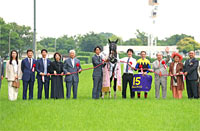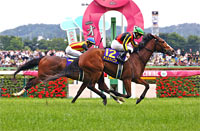Yushun Himba (Japanese Oaks) (G1) - Data Analysis
Second fillies classic
The Yushun Himba (Japanese Oaks) is a 2,400m turf race held at Tokyo Racecourse. It is 800m longer than the Oka Sho (Japanese 1000 Guineas), the first fillies classic contested on turf over 1,600m at Hanshin Racecourse. Accordingly, aptitude to a distance of 2,400m is likely to be a key factor affecting performance. As we approach this pulsating fixture, let’s look for some trends in results over the last 10 years.
Check last-but-one race
Looking at performances by runners over the last 10 years in terms of their last-but-one (second to last) race, we find that runners that contested the Tulip Sho in their last-but-one race were the only group to produce multiple winners. This group also delivered 11 Top 3 finishers, resulting in a Top 3 ratio of over 30%. [Table 1]
[Table 1] Performance by last-but-one race (last 10 years)
| Last-but-one race |
Performance
[1st-2nd-3rd-4th or lower] |
Win ratio |
Top 2 ratio |
Top 3 ratio |
| Tulip Sho |
6-2-3-24 |
17.1% |
22.9% |
31.4% |
| Daily Hai Queen Cup |
1-1-2-13 |
5.9% |
11.8% |
23.5% |
| Flower Cup |
1-1-1-24 |
3.7% |
7.4% |
11.1% |
| Hochi Hai Fillies' Revue |
1-0-0-7 |
12.5% |
12.5% |
12.5% |
| Nikkan Sports Sho Shinzan Kinen |
1-0-0-0 |
100% |
100% |
100% |
| Kisaragi Sho |
0-1-0-0 |
0% |
100% |
100% |
| Anemone Stakes |
0-1-0-9 |
0% |
10.0% |
10.0% |
| Elfin Stakes |
0-1-0-5 |
0% |
16.7% |
16.7% |
| 1-win class race |
1-2-3-28 |
2.9% |
8.8% |
17.6% |
| Newcomer or maiden race |
0-0-1-13 |
0% |
0% |
7.1% |
| Other race |
0-0-0-24 |
0% |
0% |
0% |
Note: Two runners tied for 1st in 2010.
Also watch finish in last-but-one race
Looking at performances by runners over the last 10 years in terms of finish in their last-but-one (second to last) race, we observe that the 20 Top 2 finishers and 28 of the 30 Top 3 finishers had finished in the Top 4 of their last-but-one race. In other words, we should sufficiently consider the possibility that runners that finished in the Top 4 of their last-but-one race will be chasing the top places again, regardless of their finish last time out. [Table 2]
[Table 2] Performance by finish in last-but-one race (last 10 years)
| Finish in last-but-one race |
Performance
[1st-2nd-3rd-4th or lower] |
Win ratio |
Top 2 ratio |
Top 3 ratio |
| 1st |
6-6-7-42 |
9.8% |
19.7% |
31.1% |
| 2nd |
3-2-1-34 |
7.5% |
12.5% |
15.0% |
| 3rd |
1-1-0-12 |
7.1% |
14.3% |
14.3% |
| 4th |
1-0-0-9 |
10.0% |
10.0% |
10.0% |
| 5th |
0-0-1-12 |
0% |
0% |
7.7% |
| 6th-9th |
0-0-0-26 |
0% |
0% |
0% |
| 10th or lower |
0-0-1-12 |
0% |
0% |
7.7% |
Note: Two runners tied for 1st in 2010.
Runners backed as 5th favorite last time out perform well
Looking at performances by runners over the last 10 years in terms of favoritism in their previous race, we note that 19 of the 20 Top 2 finishers and 27 of the 30 Top 3 finishers were backed as 5th favorite or higher in their previous race. In addition, runners that were backed as race favorites in their last outing achieved a Top 3 ratio of over 40%. This suggests we should raise our expectations of runners that were highly favored in their previous race. [Table 3]
[Table 3] Performance by favoritism in previous race (last 10 years)
| Favoritism in last race |
Performance
[1st-2nd-3rd-4th or lower] |
|
Top 2 ratio |
Top 3 ratio |
| 1st favorite |
5-2-4-16 |
18.5% |
25.9% |
40.7% |
| 2nd favorite |
4-2-2-20 |
14.3% |
21.4% |
28.6% |
| 3rd favorite |
0-3-0-19 |
0% |
13.6% |
13.6% |
| 4th favorite |
1-1-1-14 |
5.9% |
11.8% |
17.6% |
| 5th favorite |
1-0-1-7 |
11.1% |
11.1% |
22.2% |
| 6th-9th favorite |
0-0-1-38 |
0% |
0% |
2.6% |
| 10th favorite |
0-1-1-33 |
0% |
2.9% |
5.7% |
Note: Two runners tied for 1st in 2010.
Runners with multiple victories over 1,600m turf races are strong performers
Looking at performances by runners over the last 10 years in terms of number of wins in 1,600m turf races, we find that runners with “3 wins or more” achieved a high Top 2 ratio of 41.7% and a Top 3 ratio of 50.0%, while runners with “2 wins” also delivered a Top 3 ratio of over 30%. Although runners with “1 win” or “0 wins” together occupied 16 (over half) of the 30 Top 3 finishers, their success ratios were not impressive. In other words, we should focus on runners that have already achieved two or more victories in 1,600m turf races [Table 4]
[Table 4] Performance by number of wins in 1,600m turf races (last 10 years)
| Number of wins |
Performance
[1st-2nd-3rd-4th or lower] |
|
Top 2 ratio |
Top 3 ratio |
| 3 wins or more |
4-1-1-6 |
33.3% |
41.7% |
50.0% |
| 2 wins |
3-2-3-18 |
11.5% |
19.2% |
30.8% |
| 1 win |
2-2-2-49 |
3.6% |
7.3% |
10.9% |
| 0 wins |
2-4-4-74 |
2.4% |
7.1% |
11.9% |
Note: Two runners tied for 1st in 2010.
Seek out the winner!
Focus on performance in first race of the year
Looking at performances by the 11 winners over the last 10 years in terms of their first race of the year and finish in that race, we observe that 10 of the 11 winners had finished in the Top 2 of their first race of the year. In addition, nine of the 11 winners had contested an open-class race to start the year. This suggests we should focus on “runners that finished in the Top 2 in high-level competition” to kick off their three-year-old campaign. [Table 5]
[Table 5] Winners’ first race of the year (last 10 years)
| Year |
Winner |
First race of the year |
| 2009 |
Buena Vista |
Tulip Sho |
1st |
| 2010 |
Apapane |
Tulip Sho |
2nd |
| Saint Emilion |
3yo newcomer |
1st |
| 2011 |
Erin Court |
3yo 1-win class race |
6th |
| 2012 |
Gentildonna |
Nikkan Sports Sho Shinzan Kinen |
1st |
| 2013 |
Meisho Mambo |
Kobai Stakes |
2nd |
| 2014 |
Nuovo Record |
Tulip Sho |
2nd |
| 2015 |
Mikki Queen |
Daily Hai Queen Cup |
2nd |
| 2016 |
Sinhalite |
Kobai Stakes |
1st |
| 2017 |
Soul Stirring |
Tulip Sho |
1st |
| 2018 |
Almond Eye |
Nikkan Sports Sho Shinzan Kinen |
1st |
Note: Two runners tied for 1st in 2010.
(Michio Kawano)
|




















